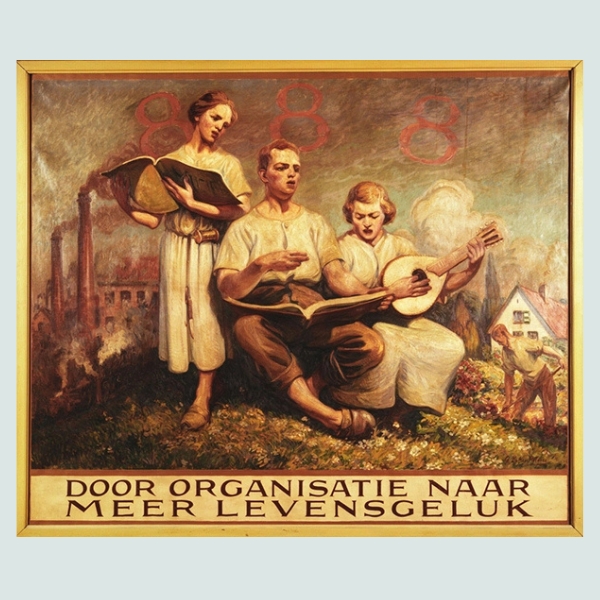Aan de ene kant van het podium hing ‘De klok slaat 5 ure!’, aan de andere kant ‘De drie achten’. De twee schilderijen vullen elkaar aan. ‘De klok’ toont waar de socialisten tegen waren, de lange werkdagen en de kinderarbeid, ‘De drie achten’ toont waarvoor ze streden: de achturige werkdag en de emancipatie van de arbeiders. De drie achten staan voor acht uur werk, acht uur ontspanning en acht uur rust.
Reeds in 1890 organiseerde de internationale socialistische beweging een strijddag voor de achturige werkdag. Als datum werd 1 mei gekozen, het begin van een traditie die van de eerste mei tot op heden een feest- en strijddag maakt. In 1890 was de achturige werkdag nog heel ver weg, een utopie als het ware. In België duurde het uiteindelijk tot 1921 vooraleer de achturendag daadwerkelijk werd ingevoerd, toen, na de Eerste Wereldoorlog, de socialisten voor het eerst deelnamen aan een regering.
Het schilderij, waarop we een jonge man en twee jonge vrouwen zien die zingen en musiceren, staat niet alleen voor het inkorten van de werkdag tot acht uur, maar ook voor het invullen van de andere uren. Naast de acht uur rust moest de arbeider tijd krijgen om zichzelf te ontwikkelen en te ontplooien. Vanaf het einde van de 19e eeuw richtte de socialistische beweging allerlei culturele verenigingen, toneelkringen, zangkoren, fanfares, leesclubs, turnclubs enz. op, met als gezamenlijk doel de emancipatie van de arbeider. Een emancipatie, waarin ook het verplicht onderwijs een belangrijke plaats innam, die de arbeider een beter leven moest bieden en hem/haar tegelijk klaarstomen om volwaardig deel te nemen aan het maatschappelijk leven.








